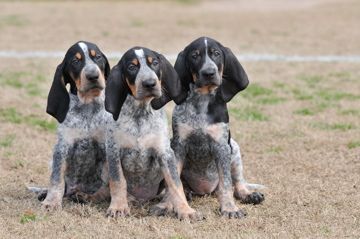
The most amusing description we’ve heard given to the American Blue Gascon Hound is that the breed is like a “cover band” for a classic hound that was developed centuries ago, the Grand Bleu de Gascogne. The “Big’n Blue,” however, is far from being a “tribute band” to that older breed.
As an aside, it must be mentioned here that the Grand Bleu de Gascogne was a remarkable breed developed in the 14th century by Gaston Pheobus de Foix. In de Foix’s day, three types of hounds were used to run deer: Tufters, or “Limiers” were cold trackers used to pick up old or “cold” scents; Chasseurs or Rauches were wicked fast hounds that brought game to bay, and ultimately, the third type of dog came in to dispatch the game. De Foix combined these qualities into one dog, the Grand Blue de Gascogne, a breed that endured fox six centuries because of its superior scenting ability, tremendous stamina, perseverance, and a long deep bawl.
Gascognes (also seen as Gascons) made their way to America with settlers of the early 1900s (though some accounts indicate that seven Gascognes were brought to the United States earlier by General Lafayette as a gift for George Washington in 1785). After the early 20th century, however, little documentation exists of their role in early American life because woodsmen and hunters didn’t keep records of their working dogs.
Decades elapsed, and more modern times brought the luxury of coonhunting as a recreational sport. The cold-nose of the old Gascon type was now a disadvantage in competition, and inevitably, a more competitive version of the old Gascon type emerged. Concerned that some of the attributes of the ancient breed were being lost, the breeding programs of men like H.O Smith, Oliver Grant, Bill Harshman, Leon Robinson, Rex Moyle and Bill Green produced the foundation dogs of the American Blue Gascon Hound.
The written history of the American Blue Gascon Hound probably began when the American Blue Gascon Hound Association was formed in 1976. It developed breed standards, and pushed for recognition. While the Grand Bleu de Gascogne is recognized by the United Kennel Club and the FCI, thus far, the American Blue is accepted only by the Dog Registry of America and the Continental Kennel Club.
At an average weight of 110 pounds, the American Blue Gascon Hound may be the largest of the scent hounds, though would be a mistake to assume that the breed is slow and clumsy. The standard calls for a well-proportioned hound with a coordinated structure which combines both speed and endurance. The American Blue demonstrates the superior traits and characteristics of the old Grand bleu de Gascogne: superb tracking, the versatility to chase prey in all conditions and terrain, and being able to bring down anything from boars, bears and bobcats to squirrels.
Big ‘n Blue pups are typically born with a great deal of white in their coat, but the coat often darkens and more black, blue, and tan markings emerge with maturity. It is the heavy black ticking that creates the “blue” appearance. They can be mistaken for a Bluetick Coonhound which is a “kissing cousin” as both count the Grand Bleu de Gascogne as an ancestor. They are known to be loyal, sweet, and affable with their families, and needless to say, are physically active dogs.
Image of American Blue Gascon Hound puppies found on Pinterest and happily credited upon receipt of information
